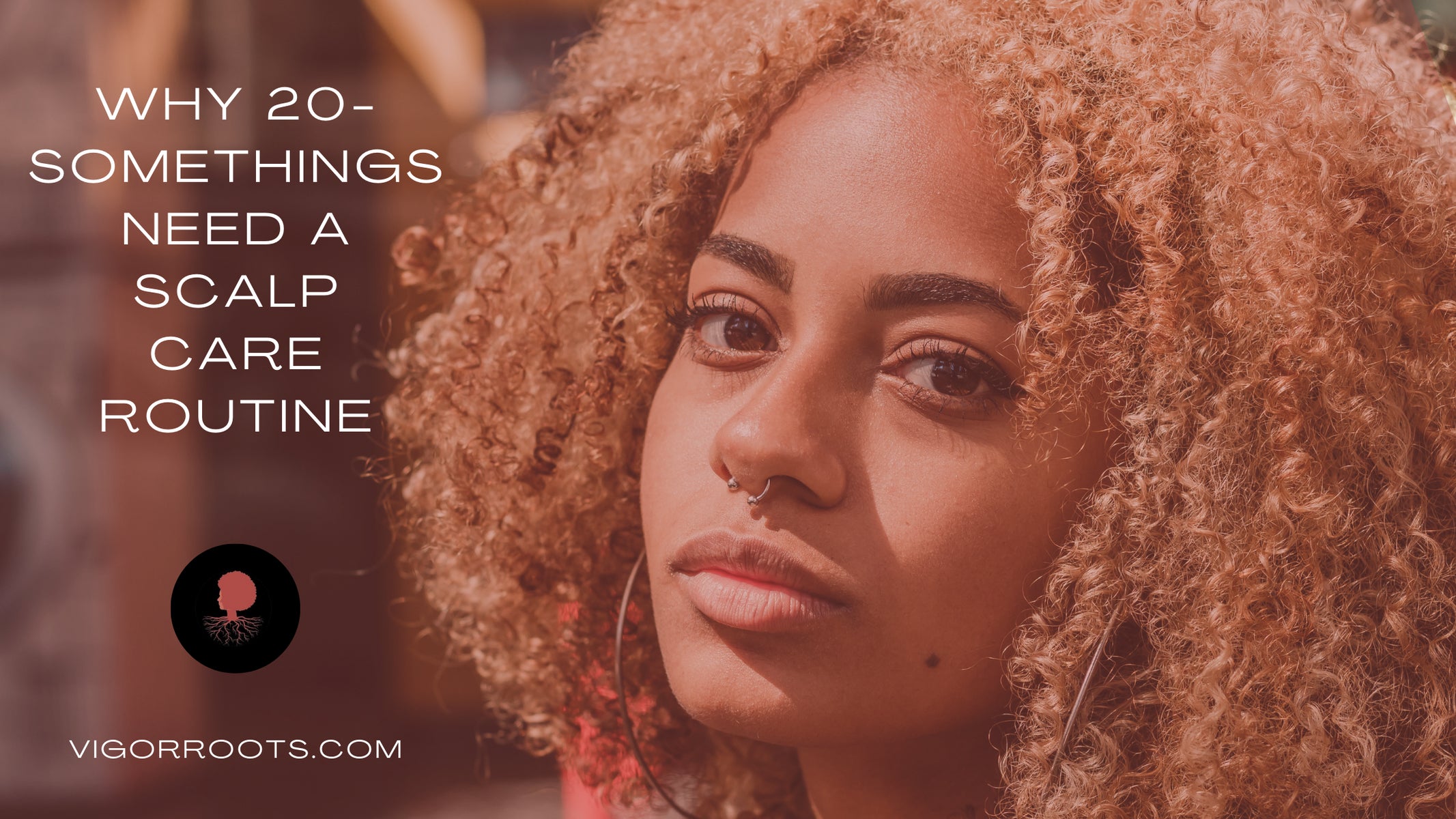
OK, we know hair thinning isn’t something many 20-somethings sit around worrying about.
Why would you? Your 20s are all about trying things out, figuring out what sort of person you want to be, and how to present yourself in a way that feels authentic and good to you.
Of course 20-somethings are constantly experimenting with bold and edgy styles. Unfortunately, too many 20-somethings aren’t fully aware of the risks they’re taking with their hair health- and how those risks can lead to preventable hair loss down the road.
In this blog post, we’ll teach you how to implement a scalp care routine that allows you to experiment to your heart’s content- without risking the long term health of your hair.
Yes, Go Wild- But Take Care of Your Scalp
Many 20-somethings don’t realize how much damage can be done to their scalps from chemical hair processes. It’s not always easy to get back to your natural color after dyeing or your natural texture after chemically straightening.
The risk increases when non-professionals attempt to chemically process their hair themselves. Improper DIY bleach, dye, or relaxers can chemically burn the scalp, weaken the hair follicles, and dry out the skin of the scalp- resulting in the growth of brittle new hairs that break off easily.
Sometimes, even professional stylists don’t properly warn their customers about potential negative outcomes from perming, bleaching, or dyeing. For instance, if your hair is already damaged (dry, brittle, split ends) you really shouldn’t dye it, as it’s likely to become even more fragile and breakable.
Similarly, if your scalp is already giving you trouble with dryness or dandruff, adding a perm, bleach, or dye will only make it worse.
Further, if you are thinking about returning to natural hair in the next few years, you should use extra caution in deciding how to style your hair. Vigor Roots CEO Nathalee DuRose warns that a return to natural hair often requires cutting off permed hair or going through a transition process that can take years.
We’re not saying you shouldn’t have fun with your hair and try out different colors and textures if that’s what makes you happy. Here’s what we are saying:
- Go to a professional stylist for any chemical processes to lessen the risk of accidentally damaging your scalp.
- Ask your stylist if your hair and scalp are healthy enough to withstand a perm, bleach, or dye.
- Ask your stylist about the risks before proceeding.
- Understand that chemical processes are likely to dry out your scalp and that you will need to incorporate more frequent moisturizing treatments into your scalp care routine.
- Invest in high quality products in order to rehabilitate the health of your scalp and hair when your hair is relaxed, bleached, or dyed.
Hair Loss Is Not Inevitable
There is a good chance no one ever taught you this before- because a lot of people still don’t know how to properly care for their scalps.
You might assume that your hair will start thinning in your 40s because your parents’ and uncles’ and aunts’ and grandparents’ hair started thinning in their 40s.
Yes, it’s true that as we age, our hair growth cycles start to lose some steam. Sometimes, it is a matter of genetics and hereditary pattern baldness. But sometimes it isn’t. Often, hair health or the lack thereof is due to scalp health or lack thereof.
So, before you write off hair thinning as a genetic certainty, consider this: what if this family history of hair loss was actually due to poor scalp care?
“My mom always said no one had ever told her how to care for her scalp,” DuRose remembers.
Even in the age of the internet, information about natural scalp care still isn’t super accessible and it can be hard to tell the good advice from the junk science. Before the internet, it was even harder to get good information on proper scalp care!
But, what if your relatives could start regrowing healthy hair now if they implemented a healthy scalp care routine? What if you never have to lose your hair at all if you start a scalp care routine?
It’s Vigor Roots’ mission to make sure every young person knows how to care for their scalps- before they have to deal with preventable hair loss.
“Later in life, you will miss your hair. We want you to take care of it now,” DuRose says.
Get Into Good Scalp Care Habits Now
Even the youngest, healthiest, most lush head of hair needs a scalp care routine.
Think about it, would you go weeks without washing your face? Of course not! So, you mustn’t do that to your scalp. And just like with your face, washing without moisturizing is a recipe for dry, uncomfortable skin. The skin on your scalp needs just as much care and attention as the skin on your face.
The thing is, it’s easier to notice when your skin care regimen for your face needs some attention. Because we can easily see the skin on our face, we notice acne, infections, rashes, or other issues when they show up on our faces.
But, our scalp is covered in hair, and, without the help of mirrors and flexibility, it’s hard to examine the skin of our scalp ourselves. When we go years and years without properly attending to the skin of our scalps, we may not notice minor skin conditions until they become much harder to miss- like a receding hairline or bald spots.
How To Have a Healthy Scalp Care Routine
Basically, for healthy hair, you need to keep your scalp pain-free, clean, moisturized, and promote good circulation. Once you get into the rhythm of proper scalp care, keeping your hair healthy becomes intuitive and easy.
Here’s what you need to do for long-lasting healthy hair.
Regularly Cleanse
Wash and condition your hair at least once a week to prevent build up and infection and keep the pores clear for healthy hair regrowth. Avoid glued-in wigs that would make it difficult to do this.
Regularly Moisturize
Regularly moisturize your scalp with a soothing, natural scalp serum. Make sure to massage the serum into your scalp to promote circulation.
Protect Your Hair While You Sleep
Before bed, gently detangle your hair and cover your scalp in a satin bonnet that secures your edges. This will prevent your hair from snagging and tangling on bedding fabrics like linen, cotton, or flannel.
You can even apply a moisturizing scalp treatment before covering with the bonnet in order to maximize benefits.
Get To Know Your Hair Type
Certain types of brushes, styling tools, and heat settings on the blow dryer will work better with your hair type than others. The wrong brush can make combing your tresses unnecessarily painful and damaging to your hair. The wrong heat setting can fry your strands.
Research and get professional advice on the right hair styling tools, heat settings, and products for your hair type. (Ask your stylist for recommendations!)
Read Labels
Use natural hair products that don’t contain harsh, harmful chemicals.
Unfortunately, many popular hair care brands contain preservatives that can dry out and irritate the scalp. Gentle, natural ingredients are more likely to nourish the skin.
Of course, you should also avoid any ingredients that you’re allergic or sensitive to.
Don’t Leave Tension Hairstyles In Too Long
In order to keep your circulation healthy and your scalp clean and clear, give your hair breaks from styles that place tension on the scalp like weaves, wigs, box braids, or other protective styles.
Vigor Roots recommends leaving protective styles in for no more than 4-6 weeks then giving your hair a 2 week break before wearing another style that places tension on the scalp.
Get a Good Stylist & Book Regular Appointments
Take care in picking an experienced stylist with a background in caring for your hair type and the styling you want.
See your stylist at least every 3 months to assess your scalp, get hair care recommendations, and get a deep condition and moisturizing treatment.
Definitely get help from a professional stylist rather than applying any chemical processes to your hair yourself.
You’ll Thank Us Later
As the song goes, “you don’t know what you’ve got til’ it’s gone.” Don’t find out what that feels like when it comes to your hair.
Have fun with your hair in your 20s, just make sure you’re taking care of your scalp.
Want to protect your crown? Check out Root22Serum- a nourishing, natural formula for a healthy scalp and long lasting, luxurious, lush hair.

